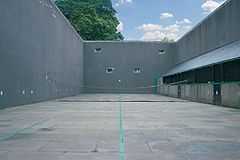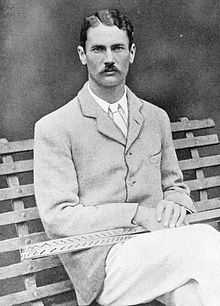Tennis in Scotland
Tennis in Scotland is a minor sport, which has obtained some prominence due to the successes of Andy Murray. While tennis courts are not uncommon, Scotland's inclement weather, and the draining of resources into British and southern English tennis has made it historically quite hard for Scottish players to break through. in certain senses, it has a low profile, for example, the only tennis inductee into the Scottish Sports Hall of Fame is Winnie Shaw. However, since 2008, Tennis Scotland's membership has increased from 32,715 to 47,657 - a rise of more than 45 per cent.[1]
Scotland competes as Great Britain in tennis, however its contribution to the pool of British players traditionally has been very poor in the modern era with almost all notable players being English. However, this has taken an about turn in recent years with emergence of Andy Murray, and doubles players Colin Fleming and Jamie Murray. Andy Murray is by some distance the best player currently representing Britain as the UK number 1 and is also the world number 2. On 7 July 2013 he became the first British player to win the men's singles at Wimbledon since Fred Perry in 1936, 77 years before. Brother Jamie and won the Wimbledon mixed doubles title along with Serbian Jelena Janković in 2007, the first time any British player had won a major title at Wimbledon in 20 years. Colin Fleming along with his English partner Ross Hutchins is currently ranked 9th in the ATP Doubles Team Rankings. There are no official ATP tournaments in Scotland however, with all major events in Britain being contested in England.
Governing body
The governing body is Tennis Scotland, which is based in Craiglockhart, Edinburgh. It has frequently seen itself as a subset of British tennis, rather than a national body in its own right.
History
Medieval History

Tennis in its earlier forms was introduced into Scotland from France in the Middle Ages. It was traditionally known as "caitch" or "cache" in Scotland, and is an ancestor of the better known form of tennis.
19th Century

In the nineteenth century, tennis was a fairly exclusive sport, with high level participation being mainly by the upper classes.
Scotland produced two Wimbledon men's champions in this period, Herbert Lawford and Harold Mahony. However, to complicate matters, Lawford was born in England but died in Scotland, and Mahony was Scottish born, but died in County Kerry, where his family were from. This perhaps demonstrates the complications of trying to assign a nationality to a sports player.
Herbert Lawford (15 May 1851 – 20 April 1925) was once co-World No. 1 tennis player and won the Men's Singles championship at Wimbledon in 1887, and was runner-up five times.
Harold Mahony is best known for winning the Wimbledon Championships in 1896. He was born at 21 Charlotte Square, Edinburgh to Richard John Mahony, an Irish barrister and prominent landowner. The family had a home in Scotland but spent most of their time at Dromore Castle, in County Kerry, Ireland. Harold trained on a specially built tennis court at Dromore.[2] Mahony was also a successful Olympian. At the 1900 Summer Olympics in Paris (France) he won a silver medal in the men's singles event and a bronze medal in the doubles tournament (for Great Britain and Ireland). Mahoney won the Kent Championships in 1899, defeating Wilberforce Eaves in the final, and in 1904, defeating Brame Hillyard in the final.
The Scottish sporting all-rounder Leslie Balfour-Melville also played tennis, but this is not as significant as his golf, cricket and rugby credentials.
Patrick Bowes-Lyon, a relative of the Queen Mother was Scottish tennis champion in 1885, 1886 and 1888, he won the doubles at Wimbledon alongside Herbert Wilberforce.
20th Century

In the 20th century, particularly the latter half, tennis became less socially stratified. However, even in the 1970s, the quality of Scottish tennis was seen as low, even featuring in a Monty Python sketch as being "well known as the worst tennis-playing nation on Earth".[3] In this sketch, extraterrestrials turn people into Scotsmen in order to win Wimbledon:
- "So these blancmanges, blancmange-shaped creatures come from the planet Skyron in the Galaxy of Andromeda. They order 48,000,000 kilts from a Scottish menswear shop ... turn the population of England into Scotsmen (well known as the worst tennis-playing nation on Earth) thus leaving England empty during Wimbledon fortnight! Empty during Wimbledon fortnight ... what's more the papers are full of reports of blancmanges appearing on tennis courts up and down the country - practising. This can only mean one thing! They mean to win Wimbledon!"[3]
Ian Collins (1903 – 1975) In 1927 he made his Wimbledon debut, the first of 12 Wimbledon Championships that he entered. He missed the Championship in 1933 after injuring himself riding, but appeared in the event every other time until 1939. His Davis Cup partnership with Colin Gregory proved successful as they were undefeated in their six matches together, in 1929 and 1930.[4] They also combined together in major tournaments and made the finals of both the Australian Championship and Wimbledon in 1929. Collins and Gregory lost to Jack Crawford and Harry Hopman in the Australian final 6-1, 6-8, 4-6, 6-1, 6-3, but beat them in the 1930 Davis Cup. They narrowly lost the Wimbledon final in another five setter, to Wilmer Allison and John Van Ryn, 6–4, 5–7, 6–3, 10–12, 6–4. Collins was also a mixed doubles finalist in the 1929 Wimbledon Championship and again in 1931. As a singles player, Collins had his best showing in 1930 when he reached the fourth round, before being eliminated by Bunny Austin. The following year he had the best win of his career when he defeated number one seed Henri Cochet in the second round of the 1931 Wimbledon Championship, 6-2, 8-6, 0-6, 6-3.[5]
Winnie Shaw (1947–1992) was the French Open finalist in both Mixed Doubles and Women's Doubles; Australian Open semi-finalist in Singles; Wimbledon semi-finalist in Women's Doubles, and quarter-finalist in Singles.
George Kelly took up tennis after his retirement from association football. Kelly started playing Tennis with Johnny King and the pair almost made the 1970 Wimbledon Championships.[6] Robin Welsh (1869 –1934) is another example of a Scottish tennis player better known for another sport, in this case curling.
With partner John Paish, John Clifton was a doubles runner-up at Newport in 1971.[7][8] Clifton also made the second round of the singles at the 1971 Wimbledon Championships and the third round of the men's doubles at the 1973 Wimbledon Championships (with Stanley Matthews).[7]
21st Century
By the 21st Century, Scottish tennis was no longer a joke, thanks partly to the efforts of Judy Murray in training up her sons Andy and Jamie Murray to serious international standard. However, it is notable that neither of the Murray brothers came up through the Scottish tennis system, nor indeed the British tennis system, and trained abroad in Spain and the USA.
Ukrainian-born Elena Baltacha, moved to Scotland as a small child, and is a four-time winner of the Aegon Award, she was also a long-term British number 1, a position she held intermittently from 2002 to 2012.[9] However, due to her absence from competition, due to knee surgery,[10] as of 17 June 2013 she holds a current world ranking of number 185 and domestic ranking of British number 4. Her career high ranking of world number 49 was achieved on 13 September 2010.[11]
Clubs

There are a number of small long established clubs, along aside new arrivals such as David Lloyd Leisure and local council run leisure centres.
External links
References
- ↑ http://www.dailyrecord.co.uk/news/scottish-news/scottish-tennis-58million-boost-capitalise-2039874
- ↑ David Randall (31 January 2010). "Scotland's only winner of a Grand Slam. So far". The Independent. Retrieved 2 April 2012.
- ↑ 3.0 3.1 http://www.ibras.dk/montypython/episode07.htm#7
- ↑ "Ian Collins (GBR)". Davis Cup Official Website.
- ↑ "Ian Glen Collins". Tennis Archive.
- ↑ Matthews, Tony (1994). The Encyclopaedia of Stoke City. Lion Press. ISBN 0-9524151-0-0.
- ↑ 7.0 7.1 ATP World Tour Profile
- ↑ ITF Pro Circuit Profile
- ↑ Jago, Richard (2 October 2002). "Mystery bug half Baltacha's march". guardian.co.uk. Retrieved 6 June 2011.
- ↑ "Numbers rise at Elena Baltacha Tennis Academy". EADT. 1 September 2012. Retrieved 19 September 2012.
- ↑ "Elena Baltacha breaks into women's top 50 rankings". BBC Sport. 14 September 2010. Retrieved 16 September 2010.
| |||||||||||||||||
| ||||||||